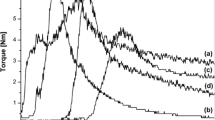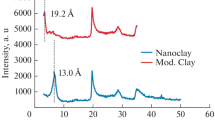Abstract
In order to improve nutrient uptake by plants and at the same time decrease losses by leaching, polymeric compounds based on biodegradable poly(3-hydroxybutyrate) (PHB) and montmorillonite clay (MMt) were melt processed with KNO3 and NPK fertilizers (Fert). We present a comprehensive analysis of releasing profile of the potassium (K+), nitrogen (NH4+ and NO3−) and phosphorous (PO43−) from PHB/MMt/fertilizer at 90/0/10, 50/0/50, 80/10/10, 40/10/50, 25/25/50 formulation. The amount and type of the fertilizer and the presence of clay delineated the release of the cations and anions from the matrix. Cations released faster than anions through MMt composites due to cations–MMt interactions and its diffusion through MMt phase. The nutrients delivery from composites was lower than pure fertilizer. Composites formulations with smaller amount of PHB and MMt (25 wt%) were enough to encapsulate the fertilizer and delay the ions releasing. Further, the simple method of preparation also attains the sustainability of the whole process.








Similar content being viewed by others
Data Availability
The raw/processed data required to reproduce these findings cannot be shared at this time due to technical or time limitations.
References
Bortolin A, Aouada FA, Mattoso LHC, Ribeiro C (2013) Nanocomposite PAAm/methyl cellulose/montmorillonite hydrogel: evidence of synergistic effects for the slow release of fertilizers. J Agric Food Chem 61:7431–7439. https://doi.org/10.1021/jf401273n
Teixeira Chagas WF, Guelfi DR, Emrich EB et al (2016) Agronomic efficiency of polymer-coated triple superphosphate in onion cultivated in contrasting texture soils1. Rev Cienc Agron 47:439–446. https://doi.org/10.5935/1806-6690.20160053
Azeem B, Kushaari K, Man ZB et al (2014) Review on materials & methods to produce controlled release coated urea fertilizer. J Control Release 181:11–21. https://doi.org/10.1016/j.jconrel.2014.02.020
Ghormade V, Deshpande MV, Paknikar KM (2011) Perspectives for nano-biotechnology enabled protection and nutrition of plants. Biotechnol Adv 29:792–803. https://doi.org/10.1016/j.biotechadv.2011.06.007
Chen J, Lü S, Zhang Z et al (2018) Science of the total environment environmentally friendly fertilizers: a review of materials used and their effects on the environment. Sci Total Environ 613–614:829–839. https://doi.org/10.1016/j.scitotenv.2017.09.186
Pereira EI, Minussi FB, Cruz CCT et al (2012) Urea−montmorillonite-extruded nanocomposites: a novel slow-release material. J Agric Food Chem 60:5267–5272. https://doi.org/10.1021/jf3001229
Grillo R, Zocal N, Maruyama CR et al (2012) Poly(ɛ-caprolactone)nanocapsules as carrier systems for herbicides: physico-chemical characterization and genotoxicity evaluation. J Hazard Mater 231–232:1–9. https://doi.org/10.1016/j.jhazmat.2012.06.019
Volova TG, Prudnikova SV, Boyandin AN (2016) Biodegradable poly-3-hydroxybutyrate as a fertiliser carrier. J Sci Food Agric 96:4183–4193. https://doi.org/10.1002/jsfa.7621
Chandra R, Rustgi R (1998) Pergamon biodegradable polymers. Prog Polym Sci 23:1273–1335. https://doi.org/10.1016/S0079-6700(97)00039-7
Amico DAD, Manfredi LB, Cyras VP (2011) Relationship between thermal properties, morphology, and crystallinity of nanocomposites based on polyhydroxybutyrate. J Appl Polym Sci 123:200–208. https://doi.org/10.1002/app.34457
Maiti P, Batt CA, Giannelis EP (2007) New biodegradable polyhydroxybutyrate/layered silicate nanocomposites. Biomacromolecules 8:3393–3400
Wee CY, Liow SS, Li Z et al (2017) New Poly[(R)-3-hydroxybutyrate- co-4-hydroxybutyrate] (P3HB4HB)-based thermogels. Macromol Chem Phys 218:1700196. https://doi.org/10.1002/macp.201700196
Bruzaud S, Bourmaud A (2007) Thermal degradation and (nano) mechanical behavior of layered silicate reinforced poly (3-hydroxybutyrate-co-3-hydroxyvalerate) nanocomposites. Polym Test 26:652–659. https://doi.org/10.1016/j.polymertesting.2007.04.001
Souza JDL, Chiaregato CG, Faez R (2017) Green composite based on PHB and montmorillonite for KNO3 and NPK delivery system. J Polym Environ 26:1–10. https://doi.org/10.1007/s10924-017-0979-4
Barud HS, Souza JL, Santos DB et al (2011) Bacterial cellulose/poly(3-hydroxybutyrate) composite membranes. Carbohydr Polym 83:1279–1284. https://doi.org/10.1016/j.carbpol.2010.09.049
Thiré RMSM, Ribeiro TAA, Andrade CT (2006) Effect of starch addition on compression-molded poly(3-hydroxybutyrate)/starch blends. J Appl Polym Sci 100:4338–4347. https://doi.org/10.1002/app.23215
Dos Santos BR, Bacalhau FB, Pereira TDS et al (2015) Chitosan-montmorillonite microspheres: a sustainable fertilizer delivery system. Carbohydr Polym 127:340–346. https://doi.org/10.1016/j.carbpol.2015.03.064
França D, Medina ÂF, Messa LL et al (2018) Chitosan spray-dried microcapsule and microsphere as fertilizer host for swellable—controlled release materials. Carbohydr Polym 196:47–55. https://doi.org/10.1016/j.carbpol.2018.05.014
Vogel C, Wessel E, Siesler HW (2008) FT-IR imaging spectroscopy of phase separation in blends of poly(3-hydroxybutyrate) with poly(L-lactic acid) and poly(E-caprolactone). Biomacromolecules 9:523–527
Lai S, Sun W, Don T (2015) Preparation and characterization of biodegradable polymer blends from poly (3-hydroxybutyrate)/poly (vinyl acetate)—modified corn starch. Polym Eng Sci 55:1321–1329. https://doi.org/10.1002/pen
Xu J, Guo BH, Yang R et al (2002) In situ FTIR study on melting and crystallization of polyhydroxyalkanoates. Polymer 43:6893–6899. https://doi.org/10.1016/S0032-3861(02)00615-8
Yang Y, Tong Z, Geng Y et al (2013) Biobased polymer composites derived from corn stover and feather meals as double-coating materials for controlled-release and water-retention urea fertilizers. J Agric Food Chem 61:8166–8174. https://doi.org/10.1021/jf402519t
Tănase EE, Popa ME, Râpă M, Popa O (2015) PHB/cellulose fibers based materials: physical, mechanical and barrier properties. Agric Agric Sci Procedia 6:608–615. https://doi.org/10.1016/j.aaspro.2015.08.099
Correa AC, Brait V, Alexandre J et al (2017) Biodegradable blends of urea plasticized thermoplastic starch (UTPS) and poly (ε-caprolactone) (PCL): morphological, rheological, thermal and mechanical properties. Carbohydr Polym 167:177–184. https://doi.org/10.1016/j.carbpol.2017.03.051
Panayotidou E, Kroustalli A, Baklavaridis A et al (2015) Biopolyester-based nanocomposites: structural, thermo-mechanical and biocompatibility characteristics of poly (3-hydroxybutyrate)/montmorillonite clay nanohybrids. J Appl Polym Sci 132:1–11. https://doi.org/10.1002/app.41628
Harmaen AS, Khalina A, Azowa I et al (2015) Thermal and biodegradation properties of poly(lactic acid)/fertilizer/oil palm fibers blends biocomposites. Polym Compos 36:576–583. https://doi.org/10.1002/pc.22974
Souza JL, Santos AF, Crespi MS, Ribeiro CA (2011) Thermal characterization of the interaction of poly(3-hydroxybutyrate) with maleic anhydride. J Therm Anal Calorim 106:453–458. https://doi.org/10.1007/s10973-011-1706-3
Ritger PL, Peppas NA (1987) A simple equation for description of solute release I. Fickian and non-fickian release from non-swellable devices in the form of slabs, spheres, cylinders or discs. J Control Release 5:23–36. https://doi.org/10.1016/0168-3659(87)90034-4
Siepmann J, Peppas NA (2001) Modeling of drug release from delivery systems based on hydroxypropyl methylcellulose (HPMC). Adv Drug Deliv Rev 48:139–157. https://doi.org/10.1016/S0169-409X(01)00112-0
Jamnongkan T, Kaewpirom S (2010) Potassium release kinetics and water retention of controlled-release fertilizers based on chitosan hydrogels. J Polym Environ 18:413–421. https://doi.org/10.1007/s10924-010-0228-6
Sankar C, Mishra B (2003) Development and in vitro evaluations of gelatin A microspheres of ketorolac tromethamine for intranasal administration. Acta Pharm 53:101–110
Pradhan R, Budhathoki U, Thapa P (2008) Formulation of once a day controlled release tablet of indomethacin based on HPMC-mannitol. Kathamandu Univ J Sci Eng Technol 4(1):55–67
Chanprateep S (2010) Current trends in biodegradable polyhydroxyalkanoates. J Biosci Bioeng 110:621–632. https://doi.org/10.1016/j.jbiosc.2010.07.014
Acknowledgements
The authors are grateful to FAPESP-Brazil (Process Number 2014/06566-9) for financial support, Bentonit União for supplying the clay, and Biocycle/PHB Industrial for supplying PHB, LCE-Structural Characterization Laboratory (UFSCAR) for SEM analysis. R. Faez is CNPq researcher.
Author information
Authors and Affiliations
Corresponding author
Additional information
Publisher's Note
Springer Nature remains neutral with regard to jurisdictional claims in published maps and institutional affiliations.
Electronic supplementary material
Below is the link to the electronic supplementary material.
Rights and permissions
About this article
Cite this article
Souza, J.L., de Campos, A., França, D. et al. PHB and Montmorillonite Clay Composites as KNO3 and NPK Support for a Controlled Release. J Polym Environ 27, 2089–2097 (2019). https://doi.org/10.1007/s10924-019-01498-9
Published:
Issue Date:
DOI: https://doi.org/10.1007/s10924-019-01498-9




